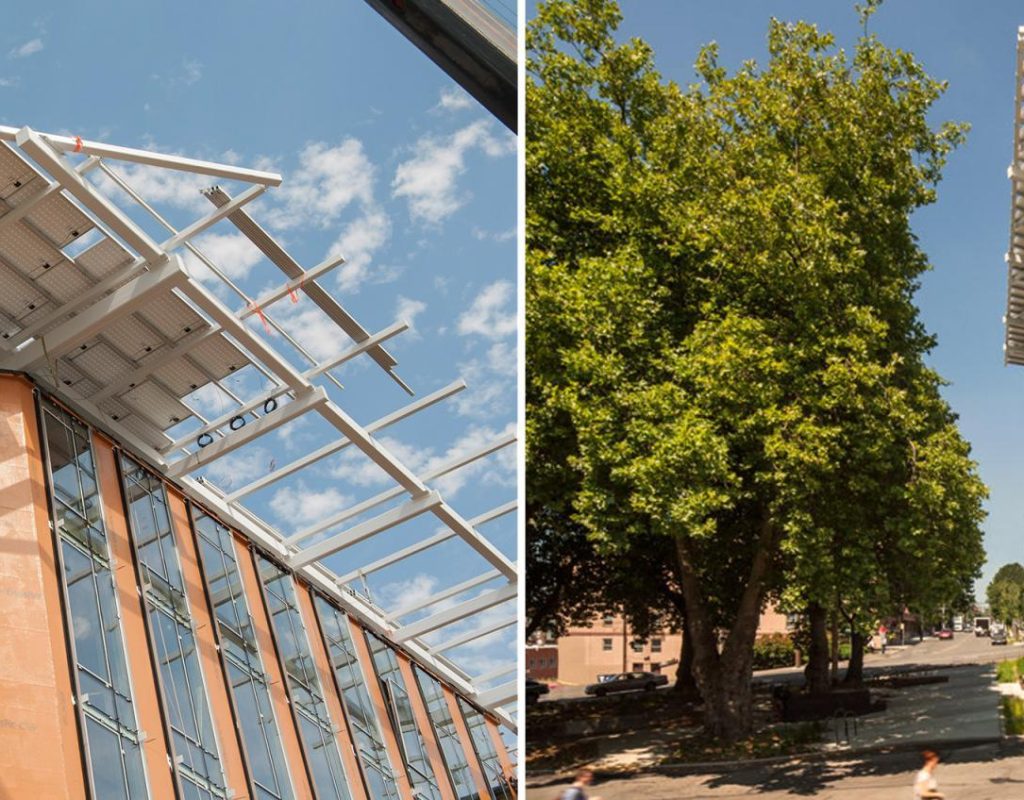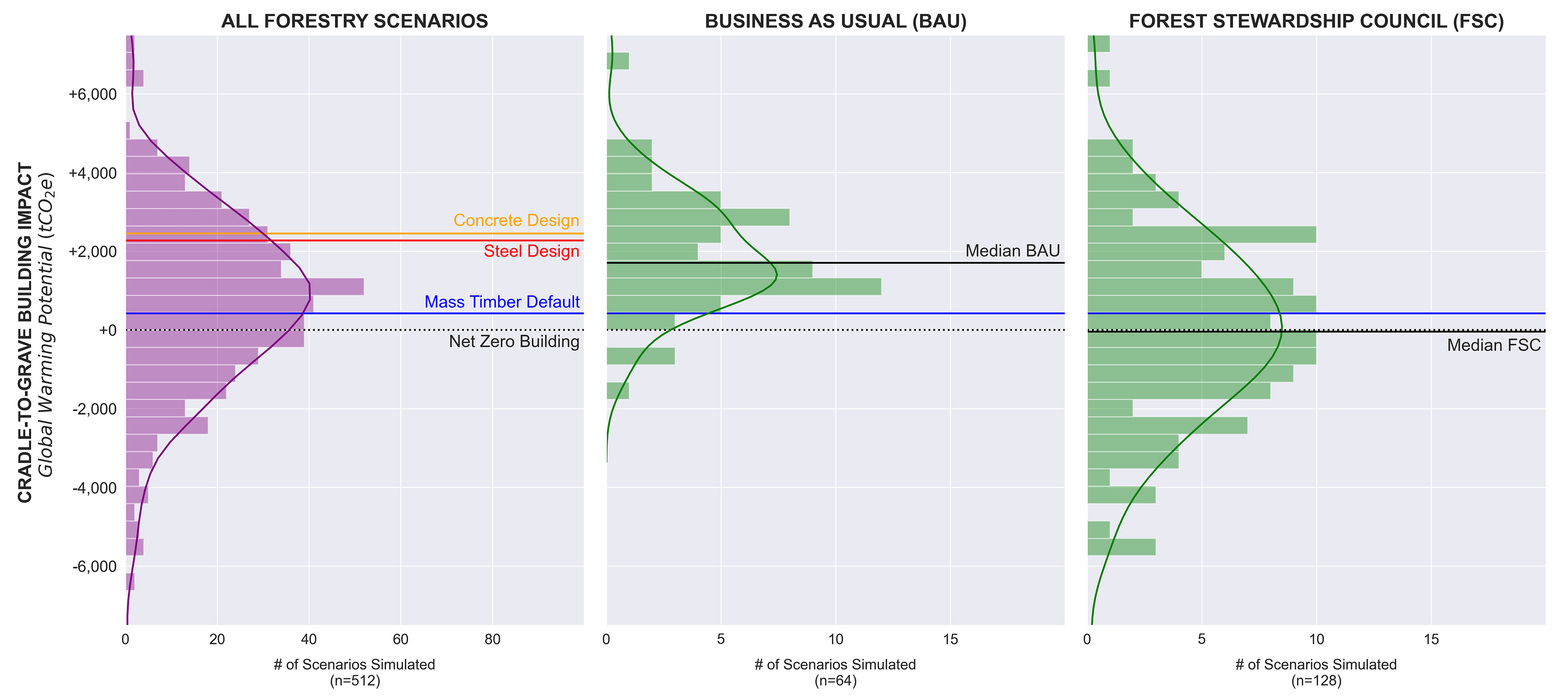
Director of Forestry Analytics & Technology
Dappled sunlight illuminates patches of the shadowy understory at Raincloud Tree Farm. Photo by Megan Foucht
Our Director of Forestry Analytics and Technology connects the dots between carbon recapture in forests and the benefit to green builders who invest in climate-smart wood products. This article was originally published in Western Forester’s October/November/December 2020 issue and appears here with permission from the Society of American Foresters Northwest Office.
I’m a forest modeling, mapping, and number-crunching nerd. Seven years ago, I got pulled into an investigation of the social and ecological impacts involved with construction of the first office building in the world to achieve Living Building certification, the Bullitt Center in Seattle. I was given what seemed like a straightforward task, yet I’m still wrestling with the same underlying question. The journey I’ve been on is not unique in the forest sector, though, and today I’d like to share that story with you.
What was my task? Quantify how management choices in the forests affected the carbon footprint of the wood used in buildings.
The urgency to drawdown greenhouse gases (GHG) and accelerate climate adaptation efforts is being felt now more strongly than ever. A growing body of research points to “Natural Climate Solutions” and large corporate and philanthropic initiatives—including several profiled in recent issues of Western Forester—are directing millions of dollars to accelerate forest carbon storage and sequestration.
The design-build community is also coming to grips with the climate crisis. Buildings produce 39 percent of global GHG emissions, and emissions from material extraction, manufacture, transport, and construction—dubbed “embodied” carbon—are now critical sustainability concerns for green builders. Life Cycle Assessment (LCA) has become the lingua franca in the world of embodied carbon, and Environmental Product Declarations (EPDs), which apply LCA to quantify the impacts of specific products are multiplying rapidly.
Forest products—mass timber products in particular—are attracting immense builder interest for functional and environmental reasons. But while concrete and steel suppliers deliver hundreds of new EPDs, the forest sector is moving slowly. Even worse, every forest product EPD presents a glaring void that more and more green builders are now noticing.

As I began digging into forest product LCAs, I found impressively detailed definitions of the GHG, energy, and material flows that were tracked or that were “out of scope.” Report after report, however, I didn’t find carbon flows from trees and forests ever included, if mentioned at all. What could possibly be going on? Trees and forest were surely baked into assessments of the life cycles of forest products, but where were they hiding?
I began noticing that carbon in biological things like plants and soils (including wood) were always treated fundamentally differently than everything else. The models I was trained to use to trace forest biomass were being entirely glossed over by a simplifying assumption known as “biogenic carbon neutrality.” The National Council for Air and Stream Improvement in its report, Recommendations on Biomass Carbon Neutrality, offers a useful definition: “a property of wood or other biomass harvested from forests where… as carbon is released from harvested wood back into the atmosphere… growing trees are removing CO2 … at a rate that completely offsets these emissions … resulting in net … biogenic CO2 emissions of zero or less.”
The current Product Category Rules (PCR), which govern the use of LCA in EPDs, simplifies carbon accounting even further with a continent-wide brush stroke: “…biogenic carbon neutrality of wood is valid for North American wood products as national-level inventory reporting shows overall increasing and/or neutral forest carbon stocks in recent years.”
Buildings produce 39 percent of global GHG emissions, and emissions from material extraction, manufacture, transport, and construction—dubbed “embodied” carbon—are now critical sustainability concerns for green builders.
In a nutshell, because national scale carbon stocks are non-declining, wood products from any and every forest in North America can be considered carbon neutral. With this single sentence, the amazing variety of management practices and systems adopted by millions of owners across wildly diverse regions got completely hidden behind a single number: zero
Contemporary EPDs offer “nutritional labels” for forest products, but leave purchasers blind to landowners intentionally doing better than average while those converting or degrading forests simply blend into the crowd. Most green builders don’t want average wood. They often go further and target specific forests and places they care about. They’re eager to use their purchasing power to make a difference and have a well-founded intuition that forestry choices actually matter.
“
As foresters, we have a lot of work ahead to communicate why forests and management matter beyond carbon.
—DAVID DIAZ
By 2016, I set out to answer questions I kept hearing from green builders and took the analysis piloted for the Bullitt Center to its logical conclusion. In 2018, we published our work in the journal Forests, which quantified how choices about green tree retention, riparian buffers, and harvest rotation lengths affected timber, carbon, and cash for Douglas-fir in western Oregon and Washington. There were too many interesting findings to unpack here (the article is Open Access if you’re curious). In brief, we confirmed what many of you probably have an intuition for already: practices that leave more and bigger trees on the landscape for longer periods of time deliver measurable carbon benefits; those benefits usually involve tradeoffs with cash flow and often with timber output or timing as well.
Although our study used carbon offset accounting instead of LCA methods, the unmet need for information like this in the design-build community was immediately clear. I was soon overwhelmed by requests to translate our findings into factors that architects could use in their building projects. Earlier this year, I was invited to give the final presentation in an eight-part webinar series hosted by the Carbon Leadership Forum about embodied carbon and wood.
What I tell architects and engineers is that the data to answer these kinds of questions are ubiquitous. County- and state-level timber product output reports are common, and extensive nationwide forest inventory data can clearly speak to their questions. Spatially explicit datasets from the NASA Carbon Monitoring System and private sector initiatives like SilviaTerra’s Basemap and the California Forest Observatory also clearly demonstrate unprecedented visibility into forests that is already at our fingertips. On the ground, every major timber producer has data at their fingertips to easily quantify and report standing inventory and harvests over time. What remains to be done, though, is for any of these data to be translated or disclosed into information the design-build community can use.

Working with architects from Miller Hull Partnership, we translated the carbon and timber outcomes from the “Tradeoffs” study into embodied carbon factors that allowed us to compare how wood produced under alternative management systems would affect the carbon footprint of a large office building under development in California that expected to use a lot of mass timber.

These graphs show the distribution of carbon stocks among counties as a percent change from 1990. Counties to the east and west of the Cascade Mountains are shown in red and blue, respectively. Dark lines show the median county for each owner type and region, and moving outward from the median, the shaded areas correspond to the 40-60th percentiles, 30-70th, etc
In my presentation to the Carbon Leadership Forum, I offered a proof-of-concept showing how this analysis works in Washington State. Using data from the NASA Carbon Monitoring System, which includes a nationwide aboveground biomass layer at 30-meter resolution every year from 1986-2018, I summarized annual timber output from reports by Washington’s Department of Natural Resources and changes in carbon stocks by ownership type (industry and non-industry private, state and local, federal, and tribal) in each of Washington’s 39 counties. These publicly available data illuminate how Washington’s forests have changed over the past 30 years.
All those trends and variability are what we replace by assuming carbon neutrality. And it makes a big difference. When I translated these data into the currency of LCAs and EPDs (kilograms of CO2-equivalent stock change per cubic meter of industrial roundwood), I could then compare how these observed changes in forest carbon stocks that are not included in LCAs compare to all the other emissions they do account for (logging, transportation, and milling and manufacturing). I found that nearly 70 percent of Washington’s wood was better than carbon neutral. I also found that a wood purchaser who shifted from the average to best-performing Washington owners and locations could easily see a carbon impact larger than eliminating all emissions to the point-of-sale combined. Shifting from Washington’s lowest- to highest-performers could easily double or triple that impact.
Practices that leave more and bigger trees on the landscape for longer periods of time deliver measurable carbon benefits.
While it’s exciting to think that this unprecedented visibility into how forests are managed could drive meaningful competition and incentivize improvements in our sector, it’s also critically important to remember that, when it comes to forests, carbon is the tail, not the dog. Virtually no one who decided to own, work in, or care about forests starts with carbon. And we can’t let architects or engineers lose sight of that either.
To add to this challenge, we also know that in many places forest management and conservation that is climate-smart may not necessarily be carbon-friendly. As foresters, we have a lot of work ahead to communicate why forests and management matter beyond carbon. But we also need to start by acknowledging that our choices in the woods actually make a difference, that we can all do better, and that some forest owners and managers are already leading the way.
This article was originally published in the Western Forester October/November/December 2020 issue. It appears here with permission from the Society of American Foresters Northwest Office. The issue is available at October/November/December 2020 | Northwest Office (forestry.org).

Project
Learn more about our work to develop actionable data to facilitate market connections for climate-smart wood producers.

Project
Learn more about online tools we’ve developed to support decision-making for land managers in Oregon and Washington.